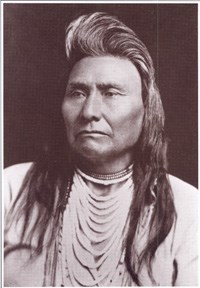
The Columbia River has a rich Native American history which dates back over 9,000 years. The many tribes of Indians who have lived along this river have seen drastic changes throughout those years, but most would say that the largest catalyst for change was the arrival of European settlers. Change came in many forms. First it was friendly conversations and trading next to a campfire when the explores were out numbered. Then more and more pioneers arrived bringing with them alcohol, religion, disease, guns and the lust for gold. Eventually the numbers turned, and it was the Native populations who were outnumbered. Treaties were signed. . . or not. Reservations were decreed, and people were moved. Some Tribes were not going to go without a fight. Among those tribes were the Nez Perce from Wallowa Valley, Oregon. The Nez Perce were divided by the Treaty of 1855. Some of the chiefs had signed the treaty because it did not affect their lands. Chief Joseph, following the direction of his father, remained unbudging and did not sign the treaty. The discovery of gold on the Nez Perce Reservation in 1860 raised calls from the settlers for a smaller reservation that would exclude the gold fields. In May 1877, the non-treaty Nez Perce were told that the U.S. Army would forcibly move them onto the new reservation. By June 1877, Chief Joseph and his people had almost reached their new reservation, which was only 1/10 the original size promised to the tribe. The day before they were to enter, four young warriors, angered by the situation and seeking revenge for the murder of one of their fathers by a white man, killed four settlers. Knowing that the Army would retaliate the Indians headed for Canada. Four months later, after many battles and defeats, and 1,300 miles they were finally captured, just 42 miles short of the Canadian boundary and refuge. Chief Joseph said; “From where the sun now stands, I will fight no more forever.” The survivors where exiled to Oklahoma, where many more died of heartbreak and sickness. In 1885, through the help of Chief Moses, Joseph and most of his people were sent to the Colville Reservation, across from Fort Spokane on the Columbia River. Before he died on September 21, 1904, Joseph made several attempts to be allowed to return to his homeland in Oregon. He was repeatedly denied. He died brokenhearted, an exile from his home. Chief Joseph is buried near Lake Roosevelt National Recreation Area on the Confederated Tribes of the Colville Reservation, and is part of Nez Perce National Historic Park. |
Last updated: October 19, 2023
